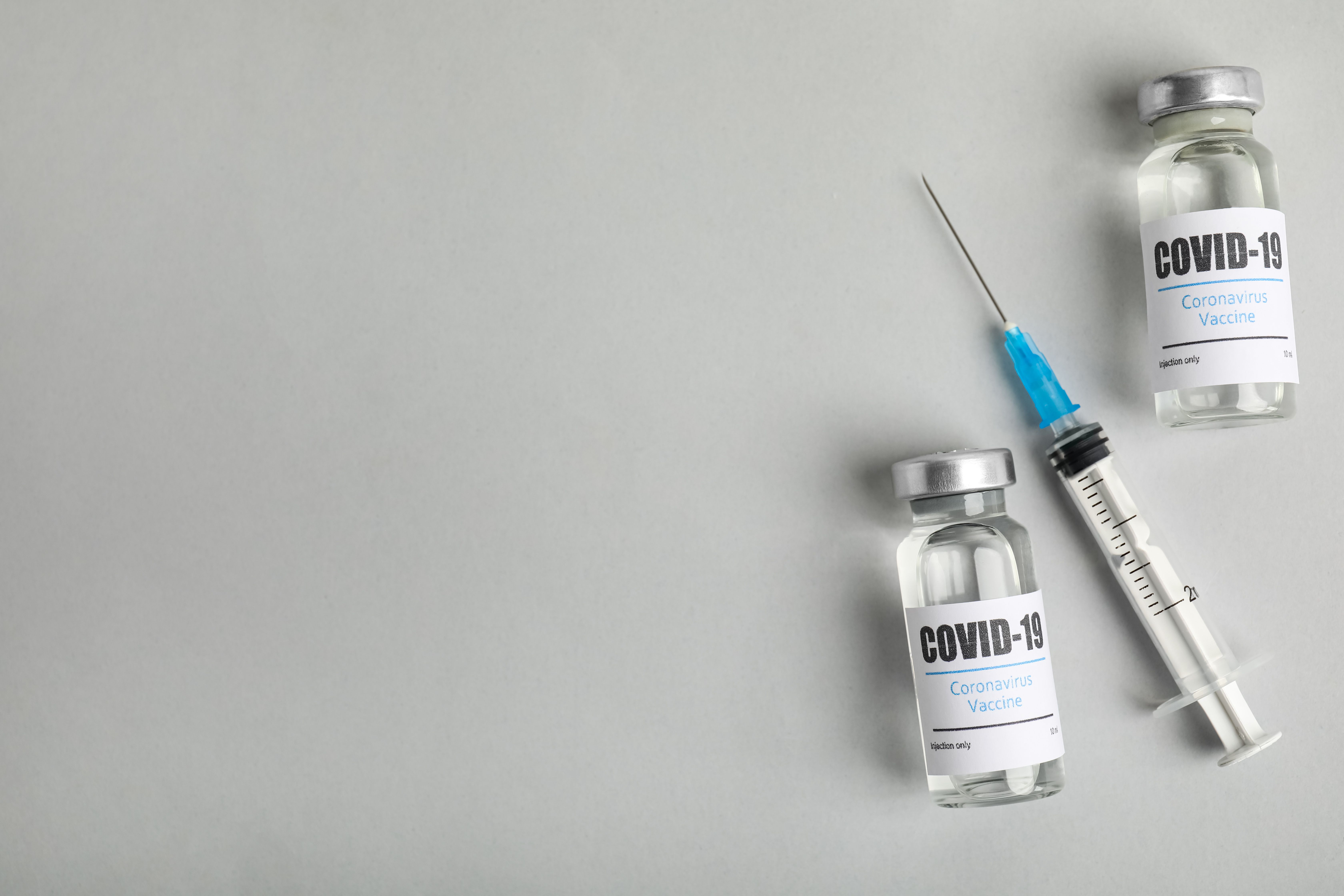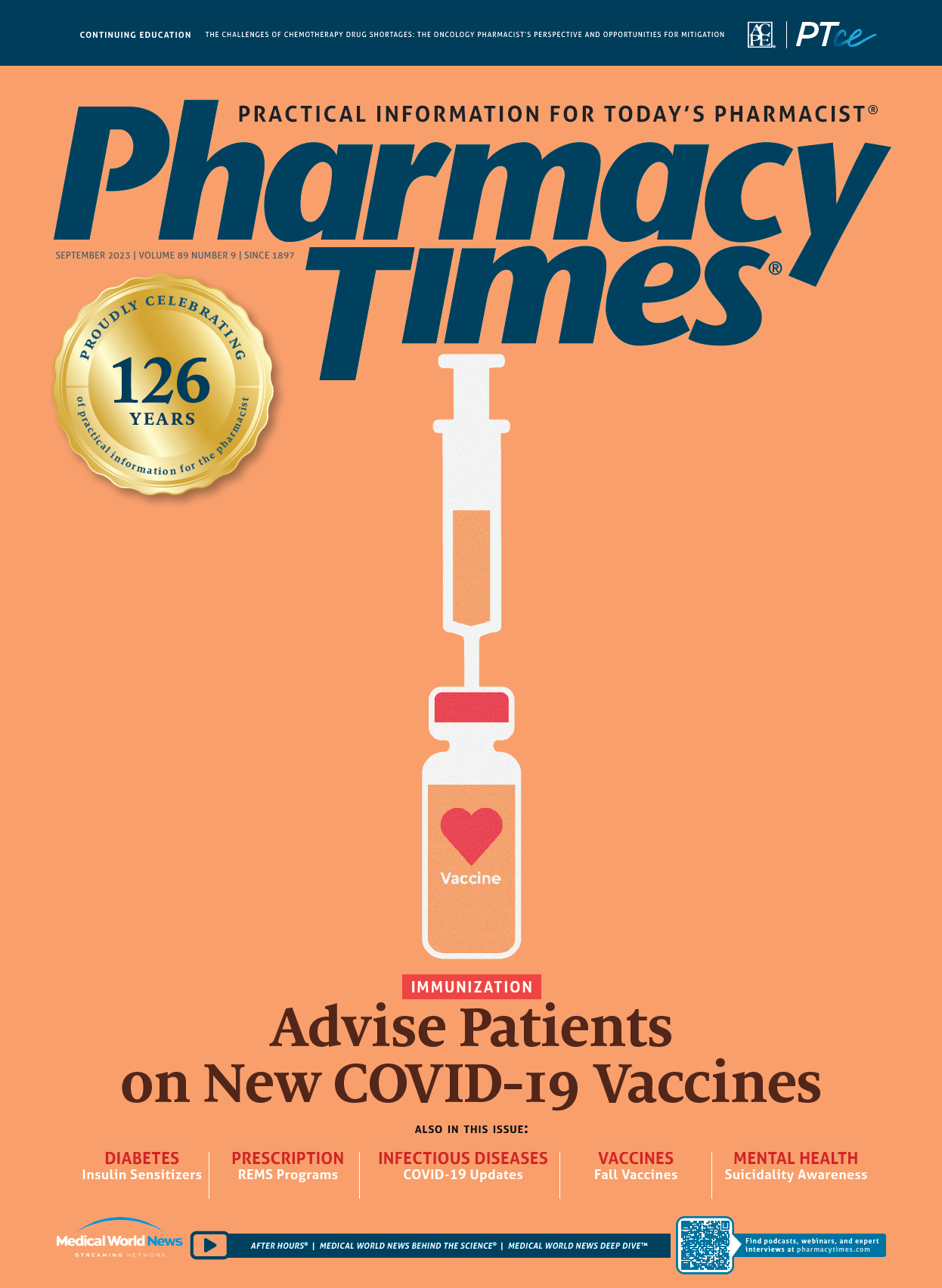Publication
Article
Pharmacy Times
Advise Patients on New COVID-19, Influenza Vaccines
Author(s):
With new vaccines expected for both SARS-CoV-2 and influenza, educate patients on the ongoing need for immunizations
The Vaccines and Related Biological Products Advisory Committee (VRBPAC) periodically meets in open session to discuss and make recommendations on the selection of strains to be included in updated COVID-19 vaccines. At the VRBPAC meeting on COVID-19 vaccines on January 26, 2023, FDA officials stated that they plan to review SARS-CoV-2 data compiled in the spring of each year and convene the VRBPAC in June of each year to determine the strains for a fall vaccine.1
Vials with coronavirus vaccine and syringe | Image credit: New Africa - stock.abobe.com

The VRBPAC met on June 15, 2023, to discuss the strain composition for the 2023-2024 formula of COVID-19 vaccines in the United States. Sublineages considered by the VRBPAC included XBB.1.5, XBB.1.16, and XBB.2.3.1 Evidence influencing their selection included virus surveillance and genomic data analysis, antigenic properties of viruses, findings from human serology studies from current vaccines, and findings from preclinical immunogenicity studies evaluating immune responses provided by candidate vaccines. The committee also reviewed timelines for manufacture of vaccines.1
For the 2023-2024 formula of COVID-19 vaccines in the United States, the committee unanimously voted in favor of recommending a 2023-2024 formula update to a monovalent XBB lineage. Based on the evidence and other considerations presented, there was a preference for selection of XBB.1.5.1 The FDA has advised manufacturers seeking to update their COVID-19 vaccines to develop vaccines with this same monovalent XBB.1.5 composition.1
As of early July 2023, United States data on the evolution of SARS-CoV-2 indicated that XBB sublineages accounted for more than 95% of the circulating virus variants. Although XBB.1.5 has declined to less than 40% of presumed circulating virus in the United States, prevalence of XBB.1.16 is on the rise and XBB.2.3 is also slowly increasing. The current path of virus evolution suggests that XBB.1.16 could be dominant by fall 2023. XBB.2.3 and other XBB sublineages could also continue to increase as the virus mutates.1
The spike protein sequences of XBB.1.5, XBB.1.16, and XBB.2.3 appear similar, with few amino acid differences. By several measures, the currently available bivalent COVID-19 (original plus Omicron BA.4/BA.5) vaccines appear less effective against currently circulating variants than against previous strains of virus. The totality of available evidence indicates that a monovalent XBB-lineage vaccine is merited for the 2023-2024 update.1
AVAILABILITY OF UPDATED COVID-19 VACCINES
Updated vaccines are expected to be made available in mid- to late September, pending FDA approval and CDC recommendation. They will be the first COVID-19 vaccines made available directly from the manufacturers as part of the commercial market rather than through the US government.2
There are an estimated 25 to 30 million uninsured adults in the United States, and there are additional adults whose insurance will not provide free coverage for COVID-19 vaccines after these products transition to the commercial market. The COVID-19 pandemic highlighted longstanding barriers to adult vaccination, including lack of accessibility, lack of availability, and lack of confidence. Under the management and oversight of the CDC, the temporary Bridge Access Program will allow adults who are uninsured or underinsured to receive free COVID-19 vaccinations.2
INFLUENZA VACCINE
Like the COVID-19 strains, influenza viruses are constantly changing. The composition of influenza vaccines in the United States is reviewed annually by the VRBPAC and updated as needed to best match the influenza viruses expected to be most common during the upcoming season. The 2023-2024 season influenza vaccines will contain an updated influenza A and 2009 H1N1 pandemic (H1N1pdm09) component3:
- Influenza A/Victoria/4897/2022 H1N1pdm09- like virus as the egg-based vaccine
- Influenza A/Wisconsin/67/2022 H1N1pdm09-like virus as the cell-based (recombinant) vaccine
How well the influenza vaccine works can depend in part on the match between the projected vaccine viruses and circulating viruses. Preliminary estimates show that during the 2022-2023 season, individuals who were vaccinated against influenza were approximately 40% to 70% less likely to be hospitalized because of influenza illness or related complications.3
The best way to prevent influenza and its potentially serious complications is by getting a yearly influenza vaccine. Even when influenza vaccination does not prevent illness entirely, it has been shown in findings from several studies to reduce severity of illness in those who are vaccinated.
TIMING INFLUENZA VACCINATION
The CDC-recommended timing of influenza vaccination has not changed. September and October are the ideal times for most individuals to be vaccinated. Influenza vaccination in July and August is not recommended for most patients, but there are several considerations regarding vaccination in July and August for specific groups3:
- For adults and pregnant women in their first or second trimester, vaccination in July and August should be avoided unless it will not be possible to be vaccinated in September or October.
- Pregnant women in their third trimester can receive an influenza vaccine in July or August to ensure the newborn is protected after birth when they are too young to receive their own vaccine.
- Children who need 2 doses of influenza vaccine should obtain the first dose as soon as it becomes available. The second dose should follow the first by at least 4 weeks.
CDC officials continue to recommend vaccination as long as influenza viruses pose a threat. During some seasons, that can be as late as May or June. They have also recommended annual vaccination for everyone 6 months or older since 2010.3
COADMINISTRATION OF COVID-19 AND INFLUENZA VACCINES
Findings from studies conducted throughout the COVID-19 pandemic indicate that it is safe to receive both an influenza vaccine and COVID-19 vaccine at the same visit. Findings from a recent CDC study showed that those who received an influenza vaccine and a COVID-19 vaccine at the same time were slightly more likely (between 8% and 11%) to have reactions including fatigue, headache, and muscle ache than those who only received a COVID-19 vaccine, but these reactions were mostly mild and went away quickly.4 The findings of this study are consistent with safety data from clinical trials that did not find any safety concerns with giving both vaccines at the same time.4
About the Author
Kathleen Kenny, PharmD, RPH, earned her doctorate from the University of Colorado Health Sciences Center. She has more than 25 years of experience as a community pharmacist and works as a clinical medical writer based in Homosassa, Florida.
References
- Updated COVID-19 vaccines for use in the United States beginning in fall 2023. FDA. June 16, 2023. Accessed August 7, 2023. https://www.fda.gov/vaccines-blood-biologics/updatedcovid-19-vaccines-use-united-states-beginning-fall-2023
- CDC to launch “Bridge Access Program” in fall 2023 to provide free COVID-19 vaccines and treatments to uninsured and underinsured adults. News release. US Department of Health & Human Services. July 13, 2023. Accessed August 7, 2023. https://www.hhs.gov/about/news/2023/07/13/cdc-launch-bridge-accessprogram-fall-2023-provide-free-covid-19-vaccines-treatmentsuninsured-underinsured-adults.html
- 2023-2024 CDC flu vaccination recommendations adopted. CDC. June 29, 2023. Accessed August 7, 2023. https://www.cdc.gov/flu/spotlights/2022-2023/flu-vaccination-recommendationsadopted.htm
- Getting a flu vaccine and a COVID-19 vaccine at the same time. CDC. Updated October 25, 2022. Accessed August 7, 2023. https://www.cdc.gov/flu/prevent/coadministration.htm

Newsletter
Stay informed on drug updates, treatment guidelines, and pharmacy practice trends—subscribe to Pharmacy Times for weekly clinical insights.





